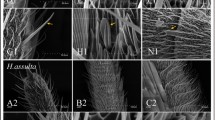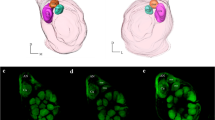Summary
Interneurones in the deutocerebrum of male cockroaches were characterised according to their intracellularly recorded responses to odours of females and to selected food odours. Following physiological characterization the interneurones were stained by the intracellular injection of dye. Some interneurones were characterized by extracellular recording and staining.
The intracellular electrodes were either placed in the somata of the interneurones or more usually in neurites between the deutocerebral glomeruli. Such recordings reveal a continuous background of synaptic potentials, and spikes at a variable but low frequency depending upon the individual interneurone. The odours, which were blown over one antenna, were a whole female extract and two purified components of this; Fraction A and a second identical to Periplanone B. Sixteen other food odours were also tested. The interneurones revealed fell into four main groups which responded to: the whole female extract and the two components, to one of the two components preferentially, and to whole female extract but neither of the components. Other interneurones were inhibited by female odours but excited by some food odours. The interneurones with these characteristics which were stained, were principal interneurones with cell bodies in the lateral cluster in the deutocerebrum, branches within the deutocerebrum confined to the macroglomerulus (an enlarged glomerulus found only in adult males), and an axon projecting to the calyces and lobus lateralis protocerebralis of the protocerebrum. The interneurones responding preferentially to Periplanone B had branches throughout the macroglomerulus, but those responding to Fraction A had a more restricted pattern of branching within the macroglomerulus.
Similar content being viewed by others
References
Bacon JP, Altaian JS (1977) A silver intensification method for cobalt-filled neurones in whole mount preparations. Brain Res 138:359–363
Boeckh J (1974) Die Reaktionen olfaktorischer Neurone im Deutocerebrum von Insekten im Vergleich zu den Antwortmustern der Geruchssinneszellen. J Comp Physiol 90:183–205
Boeckh J, Boeckh V (1979) Threshold and odor specificity of Pheromone-sensitive neurons in the deutocerebrum ofAntheraea pernyi andA. polyphemus (Saturnidae). J Comp Physiol 132:235–242
Boeckh J, Sandri C, Akert K (1970) Sensorische Eingänge und synaptische Verbindungen im Zentralnervensystem von Insekten. Z Zellforsch 103:429–446
Boeckh J, Boeckh V, Kühn A (1977) Further data on the topography and physiology of central olfactory neurones in insects. In: Le Magnen J, MacLeod P (eds) Olfaction and taste VI. Information Retrieval, London Washington DC, pp 315–321
Ernst K-D, Boeckh J, Boeckh V (1977) A neuroanatomical study on the organization of the central antennal pathways in insects. II. Deutocerebral connections inLocusta migratoria andPeriplaneta americana. Cell Tissue Res 176:285–308
Hildebrand JG, Matsumoto SG, Camazine SM, Tolbert LP, Blank S, Ferguson H, Ecker V (1980) Organisation and physiology of antennal centres in the brain of the mothManduca sexta. In: Insect neurobiology and pesticide action. Society of Chemical Industry, London, pp 375–382
Jawlowski H (1954) Über die Struktur des Gehirns bei Saltatoria. Ann Univ Mariae Curie-Sklodowska (Sect C) 8:403–434
Kafka W (1970) Molekulare Wechselwirkungen bei der Erregung einzelner Riechzellen. Z Vergl Physiol 70:105–143
Persoons CJ, Ritter FJ, Lichtendonk WJ (1974) Sex pheromones of the American cockroachPeriplaneta americana. Isolation and partial identification of two excitants. Proc K Ned Akad Wet C 77:201–204
Pitman RM, Tweedle CD, Cohen MJ (1972) Branching of central neurons: intracellular cobalt injection for light and electron microscopy. Science 176:412–414
Prillinger L (1981) Postembryonic development of the antennal lobes inPeriplaneta americana L. Cell Tissue Res 215:563–575
Pringle JWS (1938) Proprioception in insects. J Exp Biol 15:101–131
Sass H (1980) Physiological and morphological identification of olfactory receptors on the antenna of malePeriplaneta americana. In: Starre H v d (ed) Olfaction and taste VII. Information Retrieval, London, p 194
Schaller D (1978) Antennal sensory system ofPeriplaneta americana L. Distribution and frequency of morphologic types of sensilla and their sex-specific changes during postembryonic development. Cell Tissue Res 191:121–139
Selzer R (1979) Morphological and physiological identification of food odour specific neurones in the deutocerebrum ofPeriplaneta americana. J Comp Physiol 134:159–163
Simon D, Barth RH (1977) Sexual behavior in the cockroach generaPeriplaneta andBlatta. 1. Descriptive aspects. Z Tierpsychol 44:80–107
Stewart WW (1978) Functional connections between cells as revealed by dye-coupling with a highly fluorescent napthalimide tracer. Cell 14:741–759
Still WC (1979) (±)-Periplanone-B. Total synthesis and structure of the sex excitant pheromone of the American cockroach. J Am Chem Soc 101:2493–2495
Teicher MH, Stewart WB, Kaver JS, Shepherd GM (1980) Suckling pheromone stimulation of a modified glomerular region in the developing rat olfactory bulb revealed by the 2-deoxyglucose method. Brain Res 194:530–535
Waldow U (1975) Multimodale Neurone im Deutocerebrum vonPeriplaneta americana. J Comp Physiol 101:329–341
Waldow U (1977) CNS units in cockroach (Periplaneta americana): specificity of response to pheromones and other odor stimuli. J Comp Physiol 116:1–17
Yamada M (1971) A search for odour encoding in the olfactory lobe. J Physiol (Lond) 214:127–143
Author information
Authors and Affiliations
Rights and permissions
About this article
Cite this article
Burrows, M., Boeckh, J. & Esslen, J. Physiological and morphological properties of interneurones in the deutocerebrum of male cockroaches which respond to female pheromone. J. Comp. Physiol. 145, 447–457 (1982). https://doi.org/10.1007/BF00612810
Accepted:
Issue Date:
DOI: https://doi.org/10.1007/BF00612810




